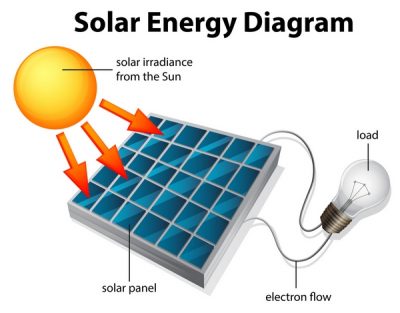Install solar panels in Alberta: FAQ
-
- How does solar PV work? What are the advantages?
When sunlight hits solar panels, it knocks out electrons out of silicone (material solar cells are made of), forcing them to move and create electric current (Direct Current). It then needs to be converted into AC (Alternating Current) with the help of an inverter, so it can be used in our house to power up lights or appliances or be sent back to the grid. Some of advantages of solar energy include sustainability, very little maintenance, high reliability and quiet operation.

How does solar energy work?
- How much solar power does Alberta get?
If you look at the data being collected by NRCan (Natural Resource Canada) annually, the amount of solar energy falling on a square meter of flat surface in Alberta is one of the highest in the country.
 For example, solar photovoltaic potential for Calgary is 1291 kWh/kW, which means that every 1 kW of installed DC power (for example, 4 solar panels of 250W each) will produce 1291 kWh of energy per year! If you compare this number with such cities as Toronto 1163 kWh/kW, Halifax – 1073 kWh/kW or Vancouver 1007 kWh/kW, you will see that Alberta is blessed with amount of solar energy we get every year! There are also amazing solar maps and tools available to homeowners, like Solar Potential Map for Calgarians located here: https://maps.calgary.ca/SolarPotential/
For example, solar photovoltaic potential for Calgary is 1291 kWh/kW, which means that every 1 kW of installed DC power (for example, 4 solar panels of 250W each) will produce 1291 kWh of energy per year! If you compare this number with such cities as Toronto 1163 kWh/kW, Halifax – 1073 kWh/kW or Vancouver 1007 kWh/kW, you will see that Alberta is blessed with amount of solar energy we get every year! There are also amazing solar maps and tools available to homeowners, like Solar Potential Map for Calgarians located here: https://maps.calgary.ca/SolarPotential/ - Are there any government solar grants or subsidies available?
Yes, there are a few solar subsidy programs currently available to homeowners and businesses in Alberta. Solar grants are offered on the provincial, as well as municipal and utility levels. In February 2017 the Government of Alberta also announced a highly anticipated Residential and Commercial Solar program (Cancelled by the United Conservative Party in May of 2019). It was expected to support installation of more than 10’000 solar rooftop projects by 2020.
- What are the steps required to install solar panels on my home?
Start with obtaining some quotes for your rooftop or ground mount solar panels installation, so you can make an informed decision. Proper site assessment, estimate for energy generation, and solar modules layout will become the basis for design, engineering, installation, and connection of your solar PV system. Your solar contractor should help you file in an application for solar panels program, contact your local electricity company, apply for electrical and building permits. Installation and connection of your solar panels array should be performed in a timely and professional manner. Your can read about questions you might want to ask your solar pv installer here
- How much solar panels cost?
That really depends on the number of factors: amount of roof space available, type of solar panels system you are looking to put in, size of the solar panels array, type and quality of mechanical and electrical components, share of government or provincial solar rebates, etc. If you are looking for a detailed quote, please fill out a request form on our website, and we’ll get back to you with a few free quotes within 24-48 hours. Make sure you are comparing “apples with apples” when it comes to choosing your solar panels contractor!
- How does it protect me against raising energy prices?
When you install a solar energy system on your property, you can save money on your electricity bills and protect yourself against higher electricity rates in the future. How much you can save depends on the utility costs and solar policies where you live, but going solar is a smart investment, regardless of your municipality.
- What is the average payback on a solar panels system
To calculate your solar panel payback period, you need to determine the combined costs and annual benefits of going solar. The components you need to consider include the total cost of installing a solar panel system; value of any financial incentives you may qualify for; your average monthly electricity use; and your estimated energy generation.
- How big of a system do I need?
There are three main factors that determine the size of solar system you’ll need:
- How many kilowatt-hours you use per month
- What percentage of your monthly power usage you want to offset with solar
- How many hours of daily sun you receive
A qualified installer can work with you to help you figure out the appropriately sized system for your home.
- What is Net Metering?
Net metering is the system utilities use to credit solar energy system owners for the electricity produced by their solar panels. With net metering, you only pay for the electricity you use beyond what your solar panels can generate. Here’s how it works: https://youtu.be/5JNw0O1zjYo
- Will I still receive a monthly electric bill if I install solar panels?
Unless your solar energy system includes home battery storage and you were able to go fully off the grid, you will still receive a bill from your electric company. However, you can slash your energy costs with a solar panel system that matches your energy use.
- Will I still receive a monthly electric bill if I install solar panels?
Unless your solar energy system includes home battery storage and you were able to go fully off the grid, you will still receive a bill from your electric company. However, you can slash your energy costs with a solar panel system that matches your energy use.
- Will solar panels work on an overcast day?
The amount of power your solar energy system can generate depends on sunlight. As a result, your solar panels will produce slightly less energy when the weather is cloudy, and no energy at night. However, because of high electricity costs and financial incentives, solar is a smart decision.
- What happens if there is snow on solar panels?
Solar panels convert sunshine into power, so if snow covers up your panels. However, since most panels are installed at an angle, the snow will slide off. If snow does accumulate, your panels are easy to clean.
- How does solar PV work? What are the advantages?




